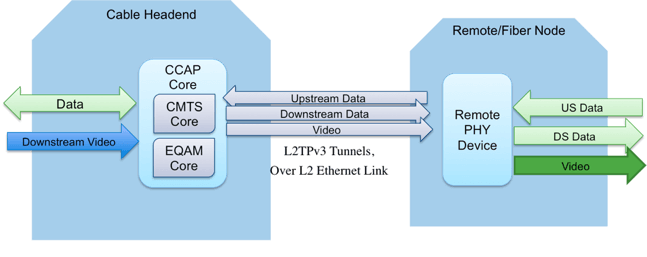DOCSIS
Remote PHY is a Reality

Just over two years ago, CableLabs announced the release of a new series of specifications known as “Remote PHY” in the blog “CableLabs® New Remote PHY Specifications expand DOCSIS® Network Deployment Options” authored by CableLabs principal architect Karthik Sundaresan. The blog describes what Remote PHY (R-PHY) is, how it forms a key piece of the various Distributed Access Architecture options we have established at CableLabs and upcoming plans for the further development of the technology.
Distributed Access Architectures and Remote PHY technology, in particular, provide several key benefits to the Hybrid Fiber Coax (HFC) networks that deliver cable TV and broadband to consumers and businesses:
- Takes full advantage of the capabilities of DOCSIS 3.1 technology, allowing more data capacity to be packed into the same amount of spectrum
- Supports the deployment of Full Duplex DOCSIS, which will enable multi-gigabit upstream services on existing cable plants
- Leverages lower cost/higher capacity optical Ethernet transport mechanisms, allowing cable operators to cost-effectively provide faster services to customers
Since this announcement, hundreds of engineers on dozens of teams from CableLabs, equipment manufacturers and cable operators worked vigorously to move the technology forward. We’re excited to announce that as a result of this hard work, interoperable Remote PHY devices (RPDs) now exist and will be available on the market soon.
What is Remote PHY Technology?: A Technical Recap
The R-PHY technology pushes the physical RF layer (PHY) to the edge of the access network. This design requires the CCAP to be “split” between the MAC layer and the PHY layer. In an R-PHY system, the integrated CCAP is separated into two distinct components. The first component is the CCAP Core and the second component is the RPD. The CCAP Core can contain both a CMTS Core for DOCSIS technology and an EQAM Core for Video.

Figure: Remote PHY High-Level Architecture
The RPD contains PHY-related circuitry, such as downstream QAM modulators, upstream QAM demodulators, together with pseudowire logic to connect to the CCAP Core. The RPD platform is a physical layer converter whose functions are:
- To convert downstream DOCSIS, MPEG video and out-of-band signals received from a CCAP Core over a digital medium, such as Ethernet or PON to analog for transmission over RF.
- To convert upstream DOCSIS and out-of-band signals received from an analog medium, such as RF to digital for transmission over Ethernet or PON to a CCAP Core.
Testing Products at CableLabs’ R-PHY Interoperability Events
While CableLabs is known for developing specifications, we also work extensively to help manufacturers develop products that conform to our specifications and interoperate with one another. One important means of doing so is through interoperability events.
The start of interoperability testing is a crucial milestone in the lifecycle of a project at CableLabs. It represents the point at which products become real and can start to work with one another. CableLabs serves as the neutral ground that allows manufacturers, who might otherwise be competitors, to come together and – for the very first time – validate whether or not their implementations work with each other and, if not, figure out why. This is a major step for manufacturers to validate their products are commercially viable.
CableLabs hosted a series of one to two-week long interoperability events, starting in December of 2016. These events comprised of 15 equipment manufacturers from around the world. The initial events included prototype RPDs and CCAP Cores which delivered product interoperability from the beginning. Over the course of time, the products matured until they became ready for use in field trials - a massive progression of development.
As participants continued through their development of RPD and CCAP Core products, features and requirements were added to the events to advance product readiness. A number of key features to enable commercial deployment were tested and verified: RPD initialization, IPv6 support, timing, DOCSIS 3.1 network operation and the creation of and communications through upstream/downstream L2TPv3 tunnels.
Announcing the Remote PHY Device Qualification Program
As an additional step to ensure devices are ready for deployment, where appropriate, CableLabs develops Qualification Programs to formally test and verify that devices comply with the specifications. This indicates that they will successfully interoperate with one another when deployed in the field. Based on the success experienced in the interoperability events to date, CableLabs is excited to announce that we have now launched a Qualification Program for the testing of RPDs.
Similar to our highly successful DOCSIS certification programs, manufacturers can now submit RPDs, whether they’re in R-PHY Nodes or R-PHY Shelves, for formal qualification testing at CableLabs. Once submitted, these devices are extensively tested by our partner Kyrio to ensure that they comply with our specifications and that they will successfully interoperate with other compliant devices.
Additional information for the RPD Qualification Program, including fees and guidelines, can be found on the Kyrio website and are described in this Kyrio blog.
Remote PHY is Real
CableLabs’ Interoperability Events help to get devices to that point and the start of our Qualification Program ensures that devices are able to demonstrate their compliance and readiness.All of this serves to demonstrate that Remote PHY is real: products are real, they are here and they’ll see deployment in the field soon. This means that cable operators – and ultimately their customers – benefit from Remote PHY deployments.
Remote PHY Industry Events & News
R-PHY is playing a major roll in the cable industry and the timing couldn’t be better! This year’s SCTE Cable-Tec Expo® in Denver, CO is holding an R-PHY seminar on Tuesday, October 17th. This event will provide an in-depth look at all aspects of R-PHY including the technology, the implementation of R-PHY and the benefits for operators. Jon Schnoor is speaking at the seminar, providing a view of the current state of the project and how CableLabs and Kyrio are playing an essential role in the next generation of cable networks.
Interested in reading more about Remote PHY in the future? Subscribe to our blog and let us know your thoughts in the comment section below.

